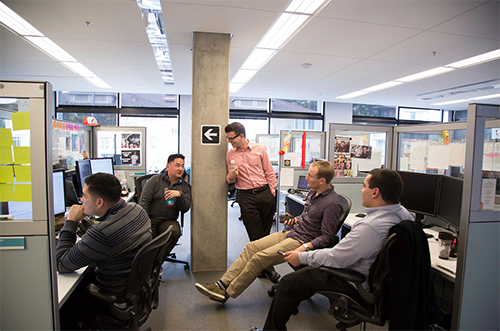When I was growing up, my family moved a lot due to my parents’ work. We lived in Japan, Australia and Hawaii just to name a few. In each place we lived, there were distinct cultural attributes that I assimilated to so that I could connect with people of the community. Some cultural aspects that were completely normal in one community were shocking in another. For example, in Japan it is an expectation to take off your shoes and put on the guest slippers offered before entering anyone’s home. In a western society like the US, people would be surprised and possibly take offense if asked to wear someone else’s shoes.
Managing an online internal community at one company and coming in to do the same at another company is presenting me with a similar kind of “culture shock.” It’s already an overwhelming task for a new employee to quickly adapt to a new community culture. On top of that adjustment, a good community manager is expected to nurture the culture of the community he or she is managing. How does an enterprise community manager transition from one culture to the next?
Last month, I blogged about 5 Tips All New Community Managers Should Consider in the First 60 Days and listed “knowing your company’s internal culture” as the number one tip to a happy, healthy and productive community. But how do you apply these cultural aspects in your community management practices? Today, I’ll take a deeper dive on what culture means with respect to community success.
What is culture?
Here are examples of cultural attributes being displayed within a community:
Transparency
Example community behavior: Majority of community members & leaders are sharing ideas, opinions, achievements and even challenges in community areas that are visible to their colleagues.
Fun
Example community behavior: Community members & leaders are playful in the content they share by using informal tone and adding humor in their content.
As a community manager, I think my role is to create a ‘safe’ environment to nurture these behaviors of cultural attributes. What do I mean by safe? I can’t assume that every single community member is happily practicing the cultural attributes in the most productive and respectable ways. Some people may have some concerns. Creating a platform or process for people to comfortably share their input openly or in private is critical so that all voices are considered.

How do I get started?
First and foremost… Identify your community culture. Check out my previous blog on how I did it. Next, If you don’t have a community guideline, make one. This is going to be the official content you are going to refer to everyone within the community so that people can understand what is expected of them to participating in positive cultural practices.
Community guideline example:
- <your community name> is where we live out <company’s name> mission to create a fundamentally better way to get work done. It is the life of <company name>, both a driver and reflection of our goal to be the most open and fun company in the world.
- Participate – <community name> is where we capture your contribution to <company name>. It is your work’s default location; not in email, on a hard drive, or a file server.
- Represent – Everything you do in <community name> represents you and your team. Demonstrate your knowledge, skill, and personality.
- Be open – Content should be open by default. Only restrict as confidentiality requires.
- Drive – Learn, share, discuss, and come to a resolution. Let your colleagues help you do it faster and better. It’s why we exist.
- Recognize others – Give credit and be generous with your praise. Call out the individuals and teams that play a part in your work.
- Keep perspective – Appreciate our collective experiences and opinions. Focus on making the right decision, rather than being right.
- Know its limits – <community name> facilitates relationship-building and collaboration; however, it does not replace a handshake, a high five, a phone call, or going to lunch with your colleagues.
And sometimes we need to remind people of etiquette:
DO:
- Be respectful of others. The golden rule “always treat people the way you would like to be treated.” These simple words of wisdom are especially important when it comes to what you say and how you say it.
- Appreciate the differences in other people. We don’t all believe the same things or have the same opinions, so if you disagree with someone’s view be respectful with your comments saying so.
- Be polite and courteous. When you’re sitting in front a computer screen, it can be hard to empathize with the people you’re talking to online. Reading hurtful words online is just as bad as hearing them in person.
- Think before you post. Could it be considered mean-spirited? Would you be comfortable if someone wrote the same things to you? The Golden Rule works as well on <your community name> as it does in real life, so do your best to respect it.
- Review, review, then send. There’s no taking back a message that’s already been sent, so it is important to double-check all writing to make sure that it clearly conveys your intended message. When in doubt, have a trusted friend review your content for any possible pitfalls.
DON’T
- Post inappropriate material or anything unlawful. This includes anything that is indecent, racist, harassing or threatening.
- Convey a critical or disrespectful attitude. Avoid posting anything that can be deemed as disruptive or derogatory.
- Write in all caps. This could be considered shouting and rude, so be mindful of how it is used.
- Use a public forum to deal with a difficult situation. If you have an issue with a way a person works or something they’ve posted, work out your differences privately and in-person, not online.

What are other examples of promoting cultural behaviors in a community as a community manager?
- Embed culture and tone in your community on-boarding training. Reference your community guidelines and etiquette as part of your on-boarding content so that all new employees are immediately introduced to the culture of a community. As part of Jive’s culture, people love to use animated GIFs to emphasize their emotions when interacting through posts and comments in our community. To assist in that cultural norm, we have a tutorial on how to get, create and use animated GIFs as part of our on-boarding content so that new employees can immediately feel included and are empowered to participate.
- Celebrate cultural attributes being displayed within your community. When people display great examples of cultural behavior, we want to recognize it. So we created a ‘Hall of Fame’ area in our community where exceptional content, discussions, and comments are featured. This is a one-stop-shop of all the greatness that has happened in the community since the time of conception and it gets handed down from one community manager to the next!
- Solicit input from the community on periodic basis. As time goes on, your community demographics may change. What was once comfortable for community members may not be the most popular thing to do now. Make sure that there is a way to get feedback from your community as to what is working and what is not working. Just because we value ‘openness’ as a cultural attribute, don’t assume that everyone is ‘working out loud’ in the community.
- Measure community sentiment on critical content. Content including popular posts and leadership blogs can help you assess sentiment over time and give you a way to objectively measure the effectiveness of community interactions.
As a new community manager, you have the responsibility to protect and nurture your community culture. You may have your own ideas about how things should be, but trying to drastically change the culture as soon as you take the post is not going to set you up for success. Instead, work towards celebrating and amplifying the positive aspects of your community’s culture.

Think of yourself as the bearer of the Olympic torch of community management where you get to protect and pass on the community legacy.
GET A PERSONALIZED DEMO
See how Jive works. Request a personalized demo.
See for yourself how Jive can drive productivity and engagement across your organization. Get a free personalized demo.